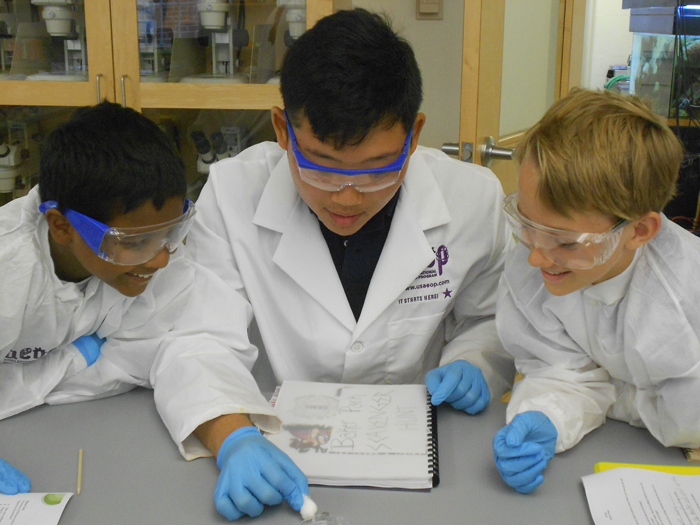GEMS Program Provides Gains for Everyone

Applications for the 2015 Gains in the Education of Mathematics and Science program Near-Peer Mentor and Resource Teacher opportunities with the U.S. Army Medical Research and Materiel Command at Fort Detrick have opened for the 10th year at Fort Detrick.
In the early 1990s, Dr. Marti Jett and Dr. Debra Yourick brought GEMS to the Walter Reed Army Institute of Research, where they decided young students needed more hands-on involvement in the lab because they wanted to maximize their potential in science, technology, engineering and mathematics fields.
Today, GEMS maintains program locations throughout the country, from Maryland to New Mexico, including all seven of the USAMRMC labs in the U.S.
As a summer STEM enrichment program, GEMS creates opportunities for elementary, middle, and high school students as well as college students and teachers.
Although students commit six weeks of their summers, GEMS requires nine weeks from its Near-Peer Mentors. Mentors receive valuable training from Army Scientists and Engineers that have volunteered their time the first and fifth weeks of the program with three weeks dedicated to leading lab activities after each training week, and a ninth week of wrap-up.
"Dr. Jett and Dr. Yourick first implemented this whole near-peer mentor concept ' college students teaching individuals who are close in age to them ' which is really the cornerstone of the GEMS program and sets it apart from the rest of the STEM programs around the country," said Lauren Beeson, educational consultant and program coordinator for Fort Detrick's GEMS program.
A GEMS mentor must be an undergraduate student majoring in a STEM or education field. As Near-Peer Mentors, the college level students act as GEMS lab instructors, subject matter experts, role models for academic success, curriculum designers, lab safety officers, technicians and as resources for students seeking academic and career guidance.
GEMS leaders, such as Beeson, stress the mentorship aspect, encouraging mentors to have lunch with the students to provide additional opportunities for discussion.
"I think students need so much to be successful. I think they need mentors they can look to and see someone who has done something they want to do, and this program provides that for them," said Beeson. "College students are the ones helping them with the experiments, and there's less of an age gap. With that smaller age gap come comfort and a lot more open communication."
In an effort to keep the boredom out of the lab, when introducing an activity or experiment, mentors cannot exceed five PowerPoint slides and 10 minutes.
"GEMS is all about hands-on learning. We won't stand up there and lecture; it's about getting your hands dirty because we want to keep that excitement up," said Beeson.
Through this paid internship, mentors work 40-hour weeks, Monday through Friday. In addition to offering this summer program as a paid internship, GEMS also offers networking and educational opportunities for the mentors.
"A lot of our near-peers say the program helps them with soft skills like public speaking, how to make a presentation and networking with scientists and engineers," said Beeson. "I'm always encouraging them to make business cards and give them out."
During the ninth week, the mentors present pieces of curricula they've written throughout the course of the program, giving them an opportunity to be creative and distribute resources for teachers to use during the regular school year.
GEMS program applications mock college applications in their requirements of an unofficial transcript, letters of recommendation and essay answers. Out of 60 students who applied to be a Near-Peer Mentor last year, Fort Detrick's GEMS program only accepted 13.
Resource Teachers also have critical roles to ensure the success of the program. They supervise the Near-Peer Mentors and manage the classrooms at a semi-removed level, floating among the different classes and allowing the mentors to take most of the lead.
They also work with the mentors to develop their curricula and guide them through several drafts.
Applicants must be current certified teachers, however they do not need to be STEM teachers.
The supervisory role Resource Teachers take gives them the experience they would need if they want to become an assistant principal, instructional specialist, or other leadership position.
"A lot of them have expressed the program is refreshing for them and rebuilds their faith in education. Teaching can be difficult and GEMS is all of the best things about teaching ' no grading and they get to work with individuals and students who are excited about what they're doing. It's fun and educational for them too," said Beeson.
Unlike the Near-Peer Mentors, Resource Teachers have a couple of choices for the duration of their participation in the program. They can either commit to four weeks or the full eight weeks.
Fort Detrick's GEMS program usually receives approximately 15 applications for Resource Teachers, and they only accept a couple.
Jett and Yourick adapted the program a few decades ago around the near-peer mentor concept, hoping they could provide a stimulating experience and a unique chance for students to dream big.
"We encourage our Near-Peer Mentors to talk to the students about what the dream-world college experience is like, making them aware at a very young age as to what they're going to have to do in order to have this incredible opportunity," said Jett. "We have them bring in pictures of their college rooms, something an eighth grader doesn't think about. Suddenly, an incredible utopia is presented to them and it provides a little incentive."
Applications for the Near-Peer Mentor and Resource Teacher opportunities close Feb. 6 and are available at
http://www.cvent.com/d/5rqnrq/4W ![]()
 .
.














